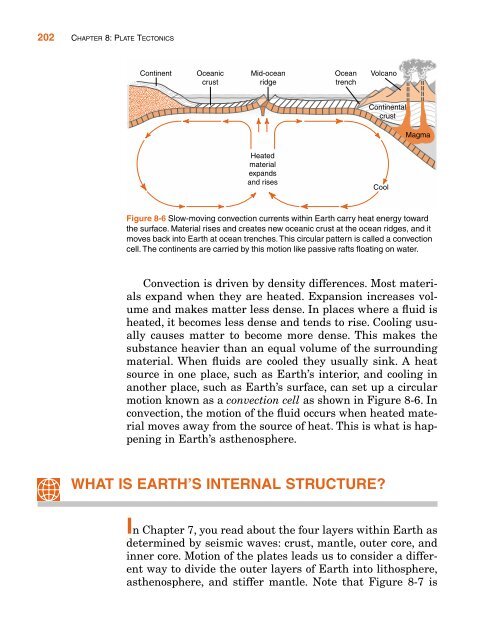Chapter 8 Plate Tectonics
Chapter 8 Plate Tectonics
Chapter 8 Plate Tectonics
You also want an ePaper? Increase the reach of your titles
YUMPU automatically turns print PDFs into web optimized ePapers that Google loves.
202 CHAPTER 8: PLATE TECTONICS<br />
Figure 8-6 Slow-moving convection currents within Earth carry heat energy toward<br />
the surface. Material rises and creates new oceanic crust at the ocean ridges, and it<br />
moves back into Earth at ocean trenches. This circular pattern is called a convection<br />
cell. The continents are carried by this motion like passive rafts floating on water.<br />
Convection is driven by density differences. Most materials<br />
expand when they are heated. Expansion increases volume<br />
and makes matter less dense. In places where a fluid is<br />
heated, it becomes less dense and tends to rise. Cooling usually<br />
causes matter to become more dense. This makes the<br />
substance heavier than an equal volume of the surrounding<br />
material. When fluids are cooled they usually sink. A heat<br />
source in one place, such as Earth’s interior, and cooling in<br />
another place, such as Earth’s surface, can set up a circular<br />
motion known as a convection cell as shown in Figure 8-6. In<br />
convection, the motion of the fluid occurs when heated material<br />
moves away from the source of heat. This is what is happening<br />
in Earth’s asthenosphere.<br />
WHAT IS EARTH’S INTERNAL STRUCTURE?<br />
In <strong>Chapter</strong> 7, you read about the four layers within Earth as<br />
determined by seismic waves: crust, mantle, outer core, and<br />
inner core. Motion of the plates leads us to consider a different<br />
way to divide the outer layers of Earth into lithosphere,<br />
asthenosphere, and stiffer mantle. Note that Figure 8-7 is
















